Modification of SmMn2O5 Catalyst with Silver for Soot Oxidation: Ag Loading and Metal–Support Interactions
Abstract
1. Introduction
2. Results and Discussion
2.1. Characterization of Catalysts
2.1.1. XRD Analysis
2.1.2. Raman Analysis
2.1.3. TEM Observation
2.1.4. XPS Analysis
2.1.5. H2-TPR Analysis
2.2. Catalytic Activity for Soot Oxidation
2.3. The Proposed Reaction Mechanism
3. Experimental
3.1. Chemicals and Materials
3.2. Catalyst Preparation
3.3. Characterizations
3.4. Catalytic Activity Measurements
4. Conclusions
Supplementary Materials
Author Contributions
Funding
Data Availability Statement
Conflicts of Interest
References
- Zhang, Y.; Pei, Y.; Liu, Q.; Gao, Y.; Min, K.; Chen, Z.; Shu, Z.; Liu, Q.; Zhou, Q.; Jiang, G. Tracing the plasma kallikrein-kinin system-activating component in the atmospheric particulate matter with different origins. J. Hazard. Mater. 2023, 458, 132044. [Google Scholar] [CrossRef] [PubMed]
- Islam, N.; Saikia, B. An overview on atmospheric carbonaceous particulate matter into carbon nanomaterials: A new approach for air pollution mitigation. Chemosphere 2022, 303, 135027. [Google Scholar] [CrossRef] [PubMed]
- Lee, E.; Lee, K.Y. NOx-assisted soot oxidation with alkaline-earth metals (Ca, Sr, Ba) loaded on Ag/2MnOx−1CeO2. J. Environ. Chem. Eng. 2023, 11, 111312. [Google Scholar] [CrossRef]
- Zhang, Y.; Lou, D.; Tan, P.; Hu, Z. Study of spatial and temporal aging characteristic of catalyzed diesel particulate filter catalytic performance used for diesel vehicle. Sci. Rep. 2020, 10, 19761. [Google Scholar] [CrossRef]
- Zheng, C.; Wu, X.; Li, Z.; Ran, R.; Weng, D. Enhanced soot oxidation activity of a CuO-doped CeO2 catalyst via acid etching. Catalysts 2023, 13, 1463. [Google Scholar] [CrossRef]
- Wang, L.; Yu, D.; Zhao, Z.; Yu, X.; Li, D.; Zhou, S.; Zhong, C.; Hou, J.; Yin, C.; Fan, X. Simultaneous removal of soot and NOx from diesel engines over three-dimensionally ordered macroporous ZSM-5-supported MMnOδ Catalysts. Ind. Eng. Chem. Res. 2023, 62, 21950–21966. [Google Scholar] [CrossRef]
- Torregrosa-Rivero, V.; Sanchez-Adsuar, M.S.; Illan-Gomez, M.J. Improving the performance of BaMnO3 perovskite as soot oxidation catalyst using carbon black during sol-gel synthesis. Nanomaterials 2022, 12, 219. [Google Scholar] [CrossRef]
- Yu, G.; Wang, J.; Ma, H.; Liu, X.; Qin, S.; Yang, Z.; Zhang, G.; Li, Y.; Zhu, L. Exploring abundantly synergic effects of K-Cu supported paper catalysts using TiO2-ZrO2 mesoporous fibers as matrix towards soot efficient oxidation. Chem. Eng. J. 2021, 417, 128111. [Google Scholar] [CrossRef]
- Sacco, N.A.; Bortolozzi, J.P.; Milt, V.G.; Miró, E.E.; Banús, E.D. One step citric acid-assisted synthesis of Mn-Ce mixed oxides and their application to diesel soot combustion. Fuel 2022, 322, 124201. [Google Scholar] [CrossRef]
- Bueno-López, A. Diesel soot combustion ceria catalysts. Appl. Catal. B Environ. 2014, 146, 1–11. [Google Scholar] [CrossRef]
- Gao, Y.; Jin, B.; Wu, X.; Li, Z.; Ran, R.; Weng, D. Co-Precipitated Mn0.15Ce0.85O2−δ catalysts for NO oxidation: Manganese precursors and Mn-Ce interactions. Processes 2022, 10, 2562. [Google Scholar] [CrossRef]
- Cao, C.; Yang, H.; Xiao, J.; Yang, X.; Ren, B.; Xu, L.; Liu, G.; Li, X. Catalytic diesel soot elimination over potassium promoted transition metal oxide (Co/Mn/Fe) nanosheets monolithic catalysts. Fuel 2021, 305, 121446. [Google Scholar] [CrossRef]
- Portillo-Vélez, N.S.; Zanella, R. Comparative study of transition metal (Mn, Fe or Co) catalysts supported on titania: Effect of Au nanoparticles addition towards CO oxidation and soot combustion reactions. Chem. Eng. J. 2020, 385, 123848. [Google Scholar] [CrossRef]
- He, J.; Yao, P.; Qiu, J.; Zhang, H.; Jiao, Y.; Wang, J.; Chen, Y. Enhancement effect of oxygen mobility over Ce0.5Zr0.5O2 catalysts doped by multivalent metal oxides for soot combustion. Fuel 2021, 286, 119359. [Google Scholar] [CrossRef]
- Guan, B.; Huang, Y.; Lin, H.; Huang, Z. Promoting effects of barium substitution on the catalytic performances of FeCeO2−δ for soot oxidation. Ind. Eng. Chem. Res. 2018, 57, 8635–8646. [Google Scholar] [CrossRef]
- Mane, R.; Kim, H.; Han, K.; Kim, K.-J.; Soo Lee, S.; Roh, H.-S.; Lee, C.; Jeon, Y. Pivotal role of MnOx physicochemical structure in soot oxidation activity. Fuel 2023, 346, 128287. [Google Scholar] [CrossRef]
- Wang, W.; Mccool, G.; Kapur, N.; Yuan, G.; Shan, B.; Nguyen, M.; Graham, U.; Davis, B.; Jacobs, G.; Cho, K.; et al. Mixed-phase oxide catalyst based on Mn-mullite (Sm, Gd)Mn2O5 for NO oxidation in diesel exhaust. Science 2012, 337, 832–835. [Google Scholar] [CrossRef] [PubMed]
- Liu, R.; Zhou, B.; Liu, L.; Zhang, Y.; Chen, Y.; Zhang, Q.; Yang, M.; Hu, L.; Wang, M.; Tang, Y. Enhanced catalytic oxidation of VOCs over porous Mn-based mullite synthesized by in-situ dismutation. J. Colloid Interface Sci. 2021, 585, 302–311. [Google Scholar] [CrossRef] [PubMed]
- Chen, L.; Zhang, C.; Wu, T.; Huang, B.; Zhang, J.; Guan, G.; Zhang, Z.; Hou, X.; Hu, C.; Lu, Q. Effects of A-site replacement (Sm, Y, and Pr) on catalytic performances of mullite catalysts for NO oxidation. Fuel 2023, 337, 126838. [Google Scholar] [CrossRef]
- Grabchenko, M.V.; Mamontov, G.V.; Zaikovskii, V.I.; La Parola, V.; Liotta, L.F.; Vodyankina, O.V. The role of metal-support interaction in Ag/CeO2 catalysts for CO and soot oxidation. Appl. Catal. B Environ. 2020, 260, 118148. [Google Scholar] [CrossRef]
- Xu, R.; Wang, X.; Wang, D.; Zhou, K.; Li, Y. Surface structure effects in nanocrystal MnO2 and Ag/MnO2 catalytic oxidation of CO. J. Catal. 2006, 237, 426–430. [Google Scholar] [CrossRef]
- Liu, H.; Dai, X.; Wang, K.; Yan, Z.; Qian, L. Highly efficient catalysts of Mn1−xAgxCo2O4 spinel oxide for soot combustion. Catal. Commun. 2017, 101, 134–137. [Google Scholar] [CrossRef]
- Machocki, A.; Ioannides, T.; Stasinska, B.; Gac, W.; Avgouropoulos, G.; Delimaris, D.; Grzegorczyk, W.; Pasieczna, S. Manganese–lanthanum oxides modified with silver for the catalytic combustion of methane. J. Catal. 2004, 227, 282–296. [Google Scholar] [CrossRef]
- Cui, B.; Zhou, K.; Hu, M.; Zhao, T.; Liu, Y.-Q.; Li, Y.; Shao, Z.; Zhao, M. The pivotal role of Ag species on porous nanosheets in the significant reduction of soot ignition temperature. Chem. Eng. J. 2023, 461, 142107. [Google Scholar] [CrossRef]
- Chen, L.; Li, T.; Zhang, J.; Wang, J.; Chen, P.; Fu, M.; Wu, J.; Ye, D. Chemisorbed superoxide species enhanced the high catalytic performance of Ag/Co3O4 nanocubes for soot oxidation. ACS Appl. Mater. Interfaces 2021, 13, 21436–21449. [Google Scholar] [CrossRef]
- Zhao, B.; Jin, B.; Wu, X.; Weng, D.; Ran, R. Ag-modified SmMn2O5 catalysts for CO and C3H8 oxidation. Catal. Commun. 2022, 167, 106456. [Google Scholar] [CrossRef]
- Jin, B.; Zhao, B.; Liu, S.; Li, Z.; Li, K.; Ran, R.; Si, Z.; Weng, D.; Xiaodong, W. SmMn2O5 catalysts modified with silver for soot oxidation: Dispersion of silver and distortion of mullite. Appl. Catal. B Environ. 2020, 273, 119058. [Google Scholar] [CrossRef]
- Ren, W.; Ding, T.; Wang, W.-L.; Zhang, Y.-X.; Li, Y.; Lu, Y.-T.; Ma, C. Microstructure and cation distribution of Mn2–xAlxZn0.2Ni0.6Mg0.2O4 high entropy oxide films. J. Mater. Sci. Mater. Electron. 2023, 34, 655. [Google Scholar] [CrossRef]
- Shen, M.; Zhao, Z.; Chen, J.; Su, Y.; Wang, J.; Wang, X. Effects of calcium substitute in LaMnO3 perovskites for NO catalytic oxidation. J. Rare Earths 2013, 31, 119–123. [Google Scholar] [CrossRef]
- Du, P.; Song, L.; Xiong, J.; Cao, H.; Xi, Z.; Guo, S.; Wang, N.; Chen, J. Electrospinning fabrication and luminescent properties of SrMoO4:Sm3+ nanofibers. J. Alloys Compd. 2012, 540, 179–183. [Google Scholar] [CrossRef]
- Ma, C.; Ma, D.-K.; Yu, W.; Chen, W.; Huang, S. Ag and N-doped graphene quantum dots co-modified CuBi2O4 submicron rod photocathodes with enhanced photoelectrochemical activity. Appl. Surf. Sci. 2019, 481, 661–668. [Google Scholar] [CrossRef]
- Zhu, Y.; Du, C.; Feng, Z.; Chen, Y.; Li, H.; Chen, R.; Shen, M.; Shan, B. Highly dispersed Pd on macroporous SmMn2O5 mullite for low temperature oxidation of CO and C3H8. RSC Adv. 2018, 8, 5459–5467. [Google Scholar] [CrossRef]
- Chu, F.; Zuo, C.; Ma, C.; Tian, Z.; Feng, T.; Zhao, C.; Wang, Y.; Dong, W.; Long, J.; Wen, Z.; et al. Solution combustion synthesis of LaxSm1−xMn2O5 nanoparticles and their electrocatalytic performances for Al-air batteries. Mater. Res. Bull. 2018, 108, 16–22. [Google Scholar] [CrossRef]
- Song, L.; Zhang, H.; Xiong, J.; Chen, Z.; Liu, Y.; Zhou, H.; Yang, W.; Cao, D.; Huang, H.; Chen, L.; et al. Doped Mn modulates the local charge distribution of cobalt-based spinel catalysts to promote the availability of ligand lattice oxygen for complete oxidation of methane. Appl. Catal. B Environ. 2024, 343, 123547. [Google Scholar] [CrossRef]
- Park, J.Y.; Dong, W.J.; Jung, S.-M.; Kim, Y.-T.; Lee, J.-L. Oxygen reduction reaction of vertically-aligned nanoporous Ag nanowires. Appl. Catal. B Environ. 2021, 298, 120586. [Google Scholar] [CrossRef]
- Clemens, K.; Shishkin, A.; Carlsson, P.; Skoglundh, M.; Martínez-Casado, F.; Matĕj, Z.; Balmes, O.; Härelind, H. Reaction-driven ion exchange of copper into zeolite SSZ-13. ACS Catal. 2015, 5, 6209–6218. [Google Scholar] [CrossRef]
- Chen, Y.; Shen, G.; Lang, Y.; Chen, R.; Jia, L.; Yue, J.; Shen, M.; Du, C.; Shan, B. Promoting soot combustion efficiency by strengthening the adsorption of NOx on the 3DOM mullite catalyst. J. Catal. 2020, 384, 96–105. [Google Scholar] [CrossRef]
- Feng, Z.; Liu, Q.; Chen, Y.; Zhao, P.; Peng, Q.; Cao, K.; Chen, R.; Shen, M.; Shan, B. Macroporous SmMn2O5 mullite for NOx-assisted soot combustion. Catal. Sci. Technol. 2017, 7, 838–847. [Google Scholar] [CrossRef]
- Chen, Y.; Du, C.; Lang, Y.; Jia, L.; Chen, R.; Shan, B. Carboxyl-modified colloidal crystal templates for the synthesis of three-dimensionally ordered macroporous SMMN2O5 mullite and its application in NOx-assisted soot combustion. Catal. Sci. Technol. 2018, 8, 5955–5962. [Google Scholar] [CrossRef]
- Nossova, L.; Caravaggio, G.; Couillard, M.; Ntais, S. Effect of preparation method on the performance of silver-zirconia catalysts for soot oxidation in diesel engine exhaust. Appl. Catal. B Environ. 2018, 225, 538–549. [Google Scholar] [CrossRef]
- Huo, Z.; Zhao, P.; Miu, P.; Ren, L.; Tan, B.; Feng, N.; Wan, H.; Guan, G. Enhanced catalytic oxidation of soot over 3DOM LaMnO3 by adding Ag and CeO2: Improving the generation and delivery of active oxygen species. Appl. Surf. Sci. 2022, 600, 154204. [Google Scholar] [CrossRef]
- Zhang, H.-L.; Zhu, Y.; Wang, S.-D.; Zhao, M.; Gong, M.-C.; Chen, Y.-Q. Activity and thermal stability of Pt/Ce0.64Mn0.16R0.2Ox (R = Al, Zr, La, or Y) for soot and NO oxidation. Fuel Process. Technol. 2015, 137, 38–47. [Google Scholar] [CrossRef]
- Xu, H.; Zeng, L.; Cui, L.; Guo, W.; Gong, C.; Xue, G. In-situ generation of platinum nanoparticles on LaCoO3 matrix for soot oxidation. J. Rare Earths 2022, 40, 888–896. [Google Scholar] [CrossRef]
- Lee, J.; Jo, D.; Choung, J.; Kim, C.; Ham, H.; Lee, K.-Y. Roles of noble metals (M = Ag, Au, Pd, Pt and Rh) on CeO2 in enhancing activity toward soot oxidation: Active oxygen species and DFT calculations. J. Hazard. Mater. 2021, 403, 124085. [Google Scholar] [CrossRef]
- López-suárez, F.; Bueno-lópez, A.; Illán-gómez, M.; Adamski, A.; Ura, B.; Trawczynski, J. Copper catalysts for soot oxidation:alumina versus perovskite supports. Environ. Sci. Technol. 2008, 42, 7670–7675. [Google Scholar] [CrossRef] [PubMed]
- Wang, M.; Zhang, Y.; Yu, Y.; Shan, W.; He, H. Insight into the better performance of Co than Pt on Ce-Sn catalyst for soot oxidation. Fuel 2023, 346, 128379. [Google Scholar] [CrossRef]
- Piumetti, M.; Bensaid, S.; Russo, N.; Fino, D. Nanostructured ceria-based catalysts for soot combustion: Investigations on the surface sensitivity. Appl. Catal. B Environ. 2015, 165, 742–751. [Google Scholar] [CrossRef]
- Wang, H.; Luo, S.; Zhang, M.; Liu, W.; Wu, X.; Liu, S. Roles of oxygen vacancy and O− in oxidation reactions over CeO2 and Ag/CeO2 nanorod model catalysts. J. Catal. 2018, 368, 365–378. [Google Scholar] [CrossRef]
- Wang, X.; Jin, B.; Feng, R.; Liu, W.; Weng, D.; Wu, X.; Liu, S. A robust core-shell silver soot oxidation catalyst driven by Co3O4: Effect of tandem oxygen delivery and Co3O4-CeO2 synergy. Appl. Catal. B Environ. 2019, 250, 132–142. [Google Scholar] [CrossRef]
- Tang, Z.; Chen, T.; Liu, K.; Du, H.; Podkolzin, S.G. Atomic, molecular and hybrid oxygen structures on silver. Langmuir 2021, 37, 11603–11610. [Google Scholar] [CrossRef]
- Yang, J.; Zhang, J.; Liu, X.; Duan, X.; Wen, Y.; Chen, R.; Shan, B. Origin of the superior activity of surface doped SmMn2O5 mullites for NO oxidation: A first-principles based microkinetic study. J. Catal. 2018, 359, 122–129. [Google Scholar] [CrossRef]
- Shimizu, K.; Katagiri, M.; Satokawa, S.; Satsuma, A. Sintering-resistant and self-regenerative properties of Ag/SnO2 catalyst for soot oxidation. Appl. Catal. B Environ. 2011, 108–109, 39–46. [Google Scholar] [CrossRef]
- Qu, Z.; Huang, W.; Cheng, M.; Bao, X. Restructuring and redispersion of silver on SiO2 under oxidizing/reducing atmospheres and its activity toward CO oxidation. J. Phys. Chem. B 2005, 109, 15842–15848. [Google Scholar] [CrossRef] [PubMed]
- Bukhtiyarov, A.; Stakheev, A.; Mytareva, A.; Prosvirin, I.; Bukhtiyarov, V. In situ XPS study of the size effect in the interaction of NO with the surface of the model Ag/Al2O3/FeCrAl catalysts. Russ. Chem. Bull. 2015, 64, 2780–2785. [Google Scholar] [CrossRef]
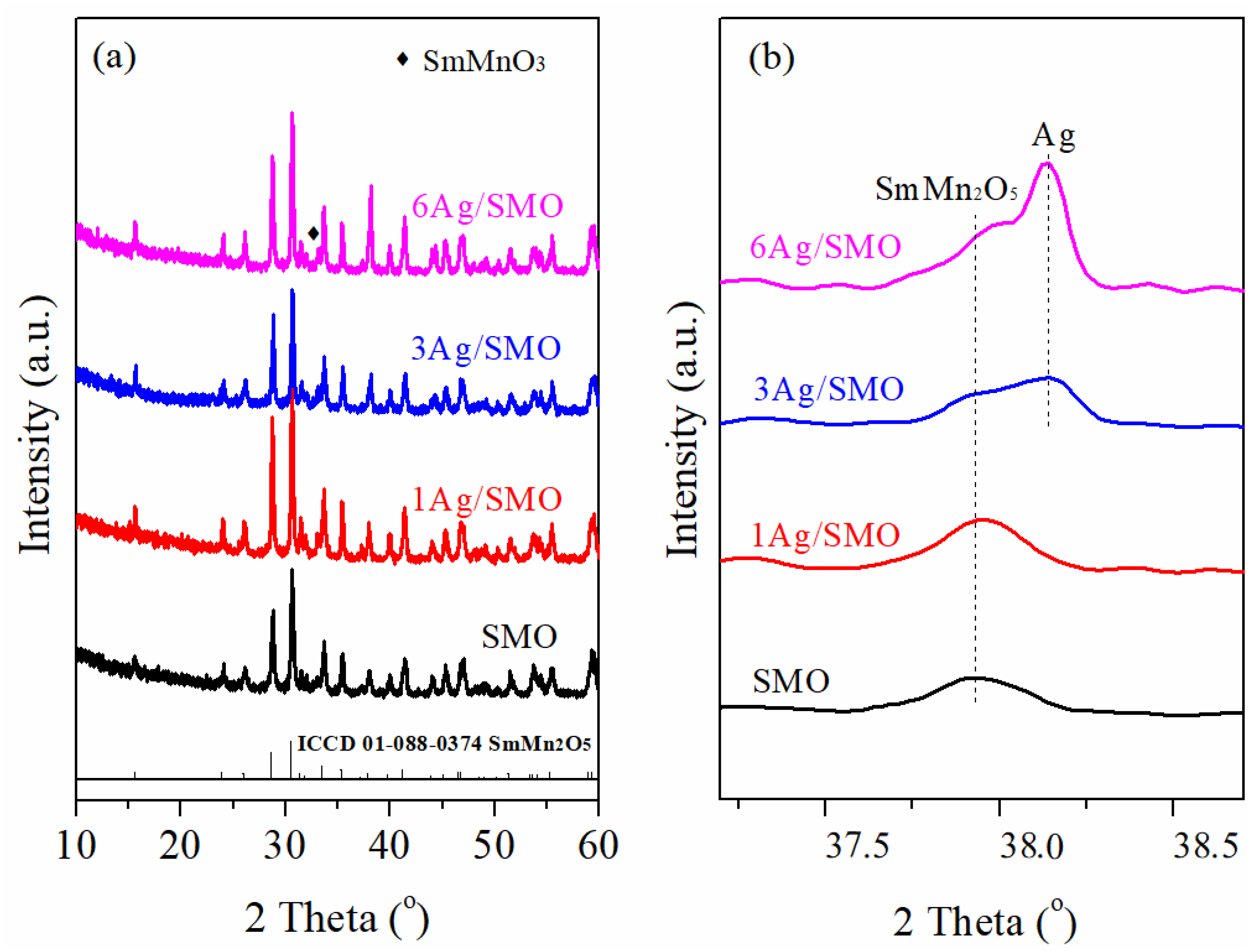
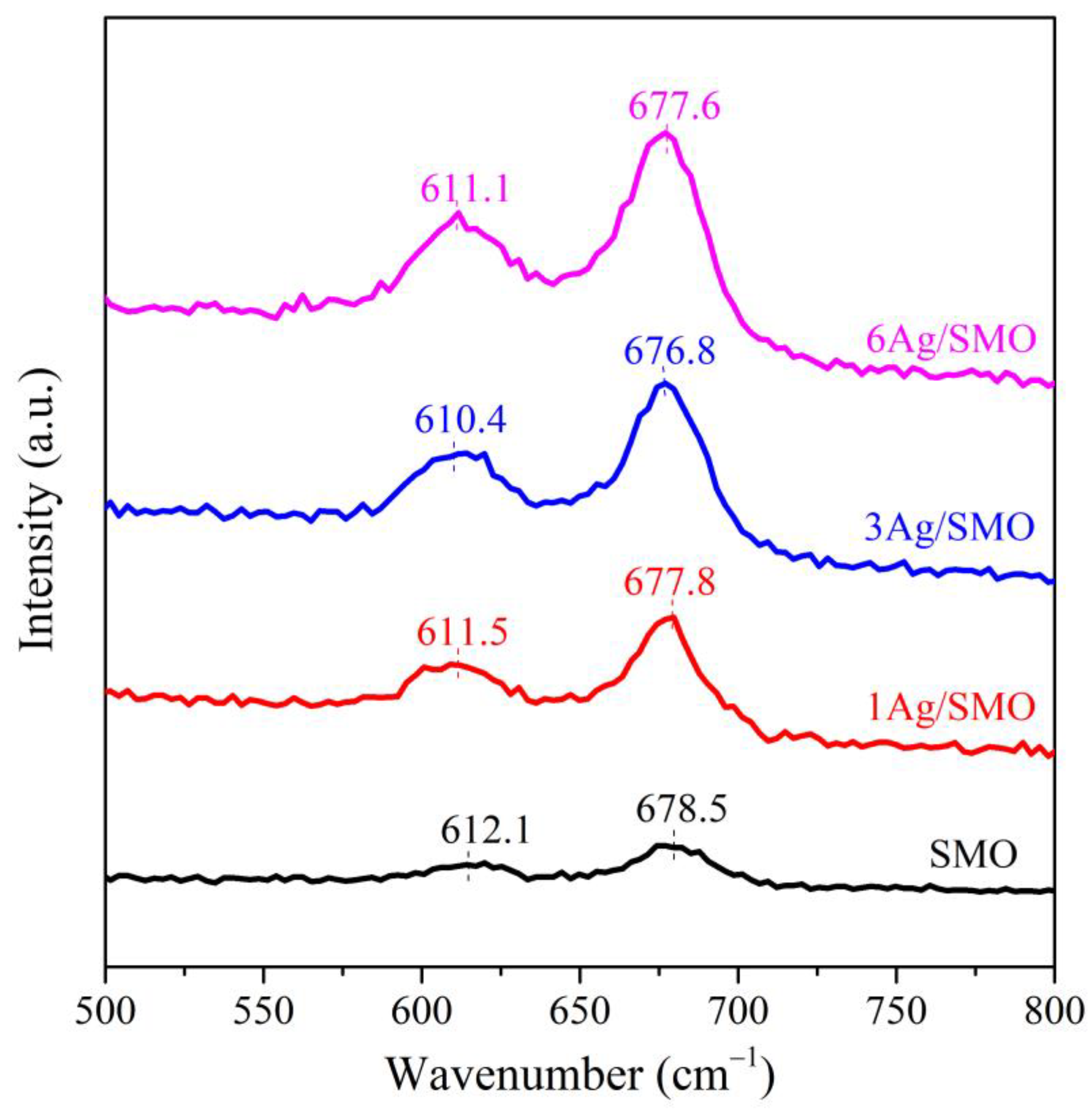
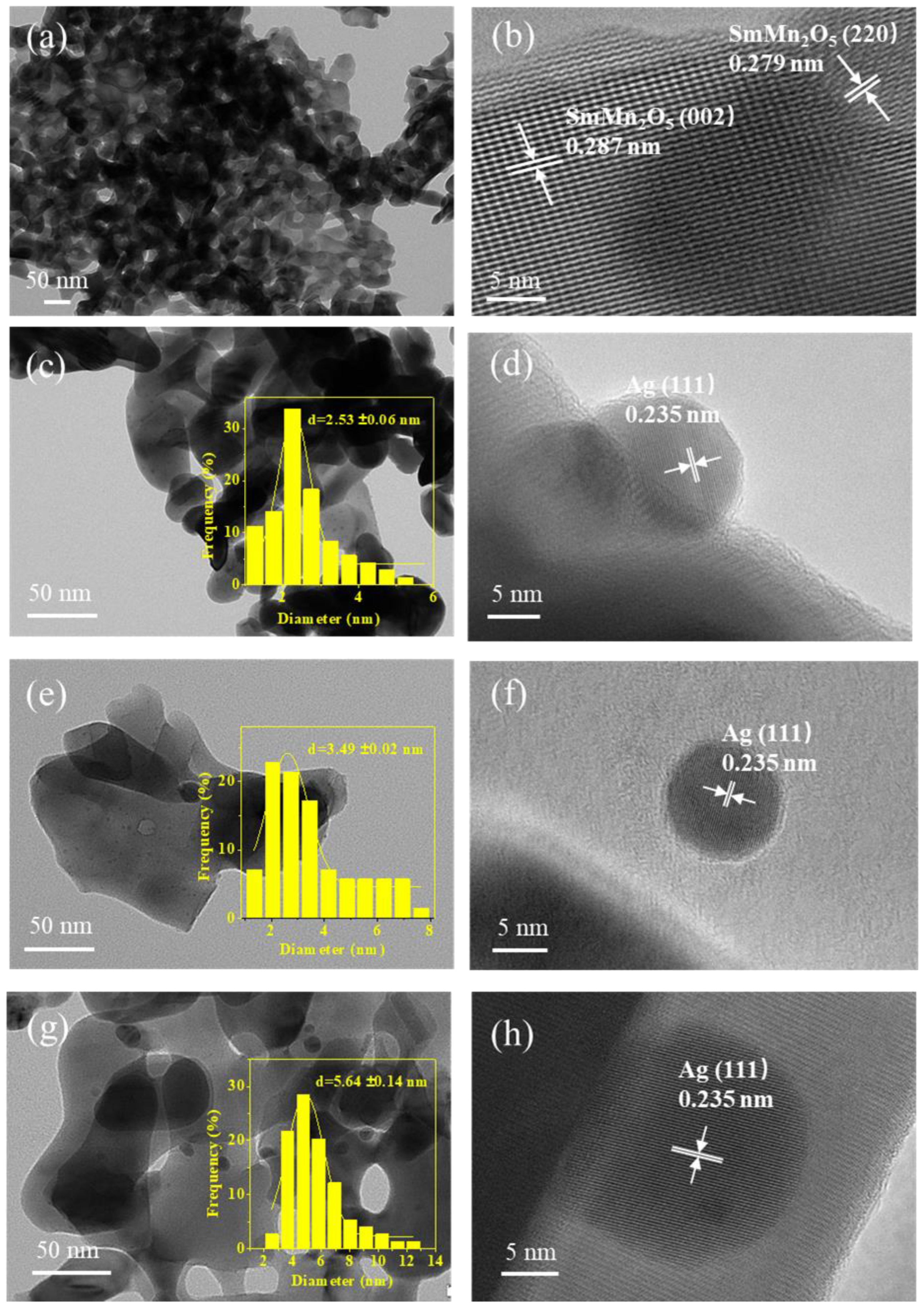
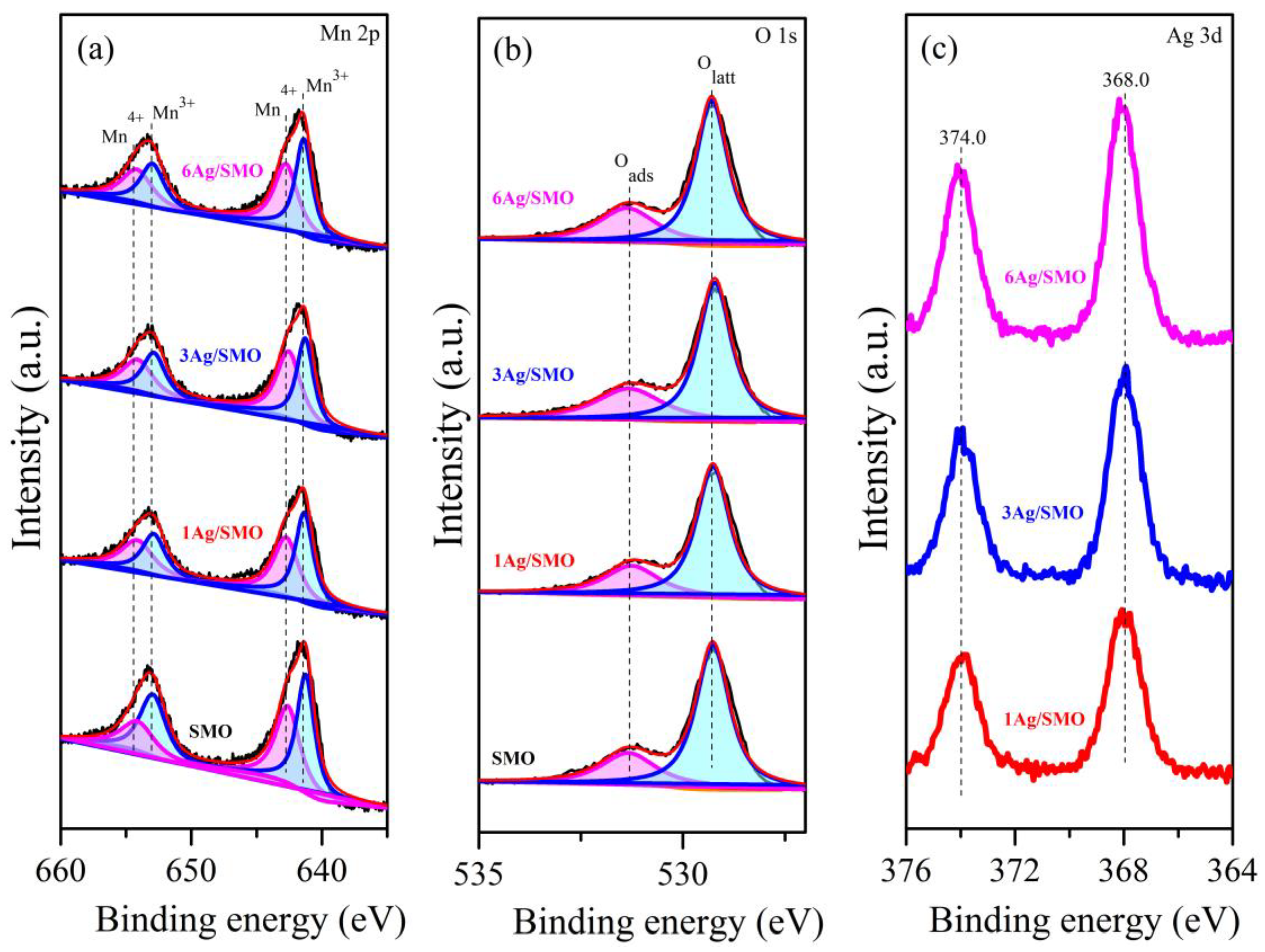
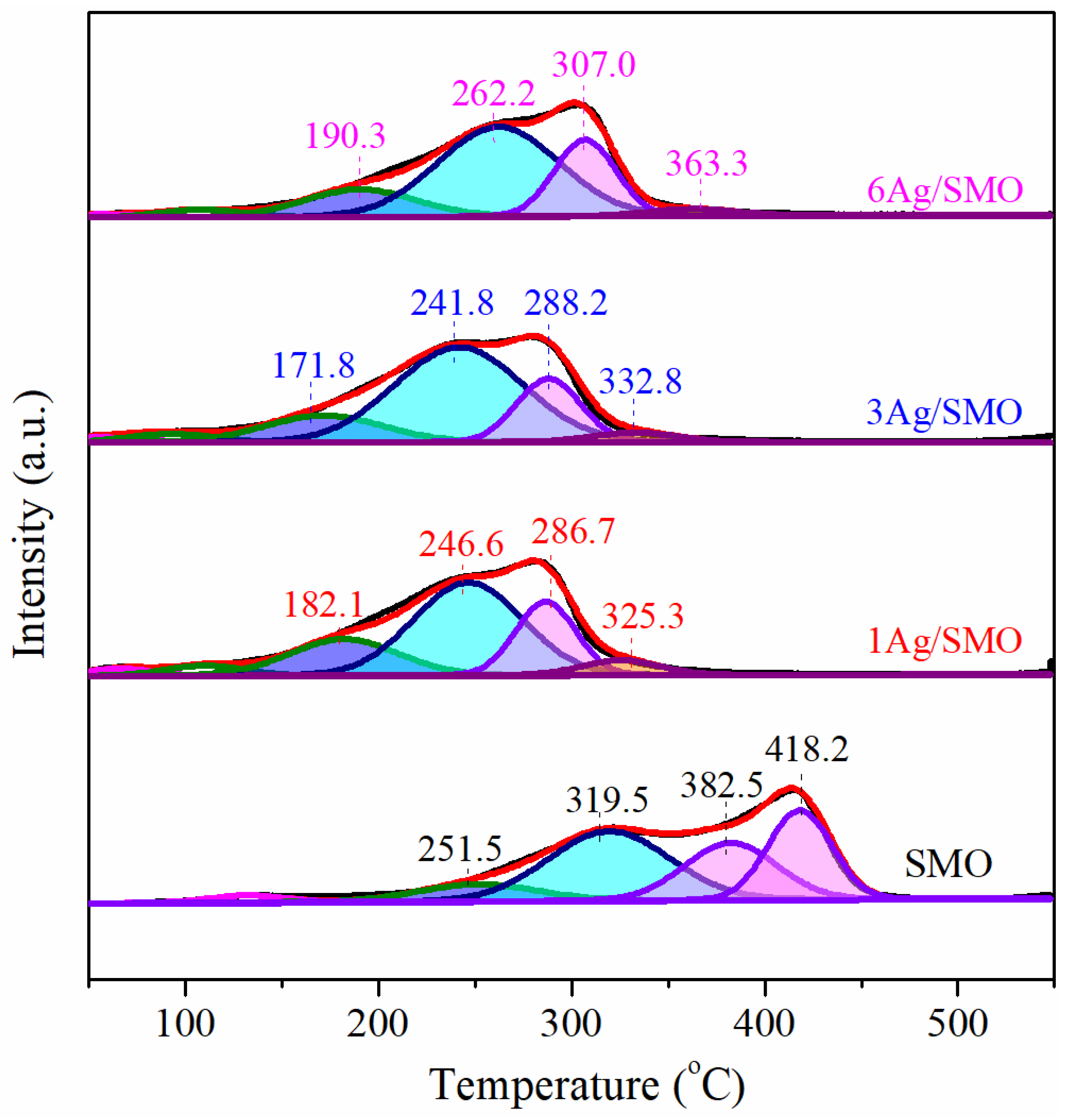
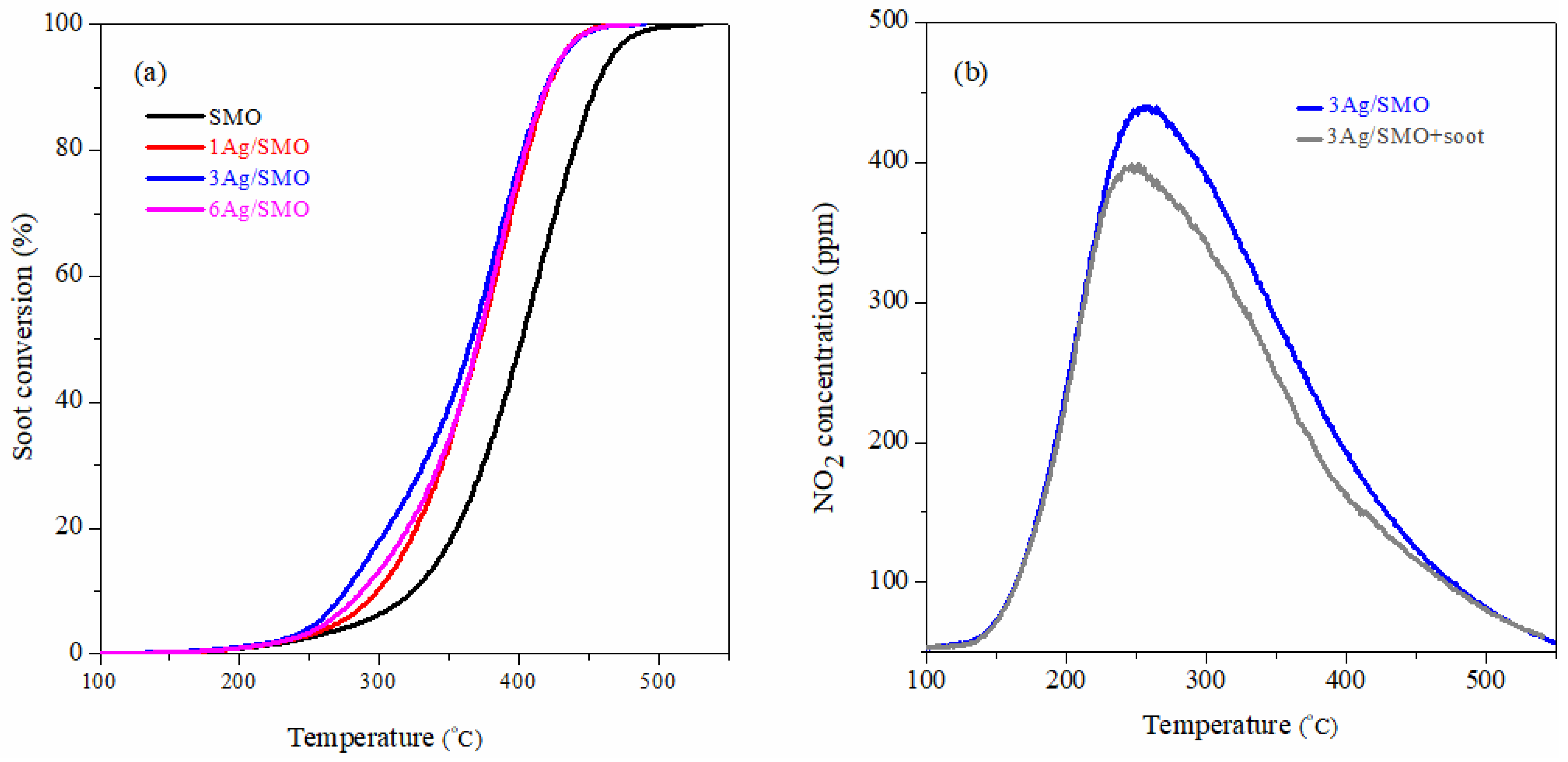
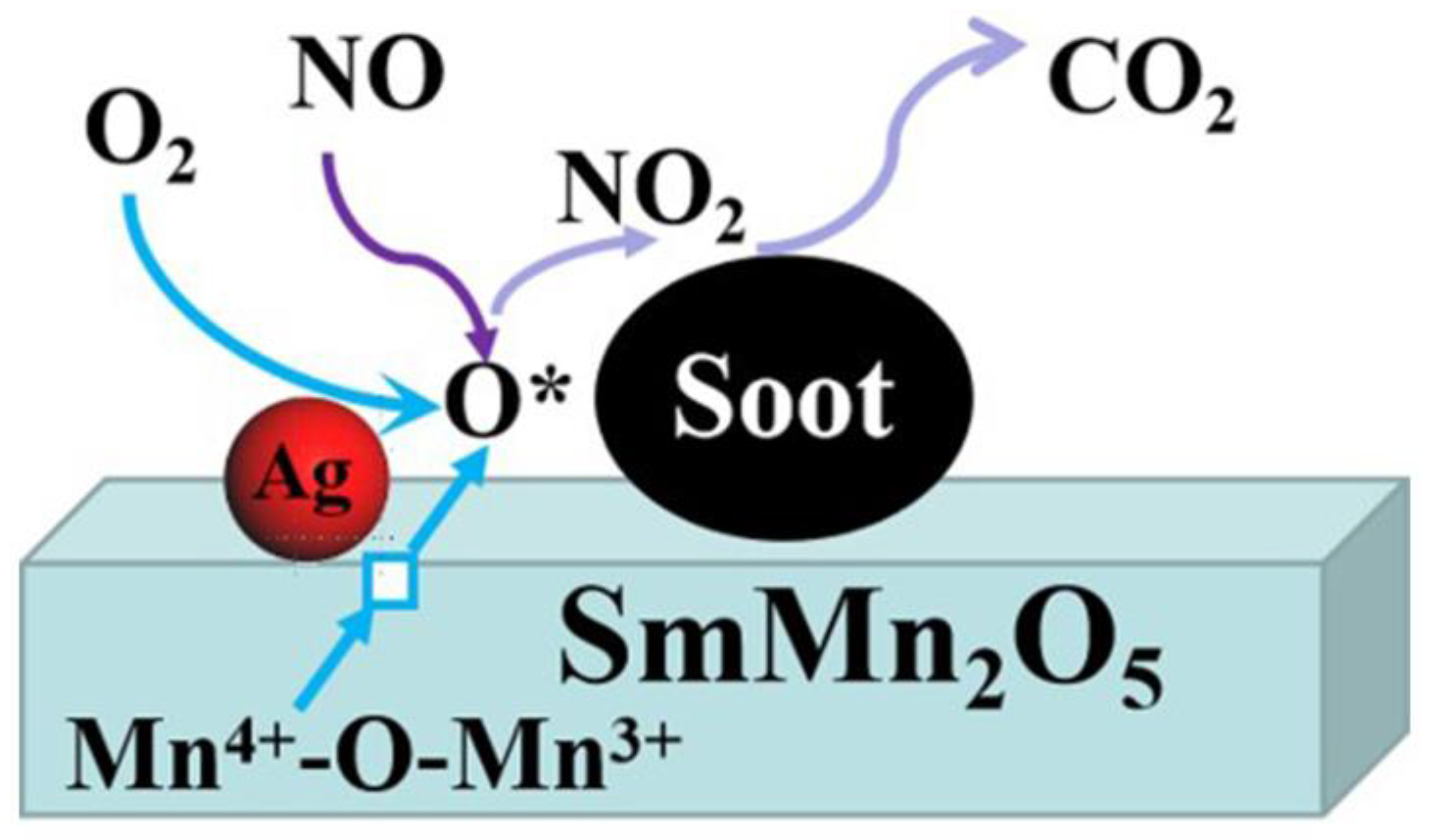
| Catalyst | Cell Parameter a | dSmMn2O5 b (nm) | SBET c (m2/g) | |||
|---|---|---|---|---|---|---|
| a (nm) | b (nm) | c (nm) | a × b × c (nm3) | |||
| SMO | 0.7502 | 0.8503 | 0.5704 | 0.3638 | 30.4 | 16.2 |
| 1Ag/SMO | 0.7477 | 0.8548 | 0.5665 | 0.3620 | 39.5 | 13.7 |
| 3Ag/SMO | 0.7429 | 0.8525 | 0.5662 | 0.3585 | 40.4 | 10.6 |
| 6Ag/SMO | 0.7455 | 0.8530 | 0.5686 | 0.3615 | 40.3 | 11.7 |
| Catalyst | Surface Content (wt.%) a | Mn4+/Mn3+ a | Oads/Olatt a | Mn4+/(Mn4+ + Mn3+) b | |||
|---|---|---|---|---|---|---|---|
| Sm | Mn | O | Ag | ||||
| SMO | 40.2 | 32.4 | 27.4 | --- | 0.53 | 0.48 | 0.43 |
| 1Ag/SMO | 40.4 | 28.5 | 24.8 | 6.3 | 0.70 | 0.63 | 0.69 |
| 3Ag/SMO | 38.2 | 28.1 | 26.1 | 7.6 | 0.73 | 0.65 | 0.74 |
| 6Ag/SMO | 38.7 | 27.3 | 25.8 | 8.2 | 0.71 | 0.62 | 0.70 |
| Catalyst | T10 (°C) | T50 (°C) | T90 (°C) | SCO2 (%) |
|---|---|---|---|---|
| SMO | 323 | 403 | 456 | 99.4 |
| 1% Ag/SMO | 300 | 372 | 420 | 99.7 |
| 3% Ag/SMO | 278 | 367 | 420 | 99.8 |
| 6% Ag/SMO | 290 | 372 | 421 | 99.9 |
Disclaimer/Publisher’s Note: The statements, opinions and data contained in all publications are solely those of the individual author(s) and contributor(s) and not of MDPI and/or the editor(s). MDPI and/or the editor(s) disclaim responsibility for any injury to people or property resulting from any ideas, methods, instructions or products referred to in the content. |
© 2024 by the authors. Licensee MDPI, Basel, Switzerland. This article is an open access article distributed under the terms and conditions of the Creative Commons Attribution (CC BY) license (https://creativecommons.org/licenses/by/4.0/).
Share and Cite
Jin, B.; Liu, Y.; Ma, Y.; Li, Z.; Li, K.; Liu, S.; Ran, R.; Wu, X. Modification of SmMn2O5 Catalyst with Silver for Soot Oxidation: Ag Loading and Metal–Support Interactions. Catalysts 2024, 14, 135. https://doi.org/10.3390/catal14020135
Jin B, Liu Y, Ma Y, Li Z, Li K, Liu S, Ran R, Wu X. Modification of SmMn2O5 Catalyst with Silver for Soot Oxidation: Ag Loading and Metal–Support Interactions. Catalysts. 2024; 14(2):135. https://doi.org/10.3390/catal14020135
Chicago/Turabian StyleJin, Baofang, Yuxin Liu, Yue Ma, Zhenguo Li, Kaixiang Li, Shuang Liu, Rui Ran, and Xiaodong Wu. 2024. "Modification of SmMn2O5 Catalyst with Silver for Soot Oxidation: Ag Loading and Metal–Support Interactions" Catalysts 14, no. 2: 135. https://doi.org/10.3390/catal14020135
APA StyleJin, B., Liu, Y., Ma, Y., Li, Z., Li, K., Liu, S., Ran, R., & Wu, X. (2024). Modification of SmMn2O5 Catalyst with Silver for Soot Oxidation: Ag Loading and Metal–Support Interactions. Catalysts, 14(2), 135. https://doi.org/10.3390/catal14020135









